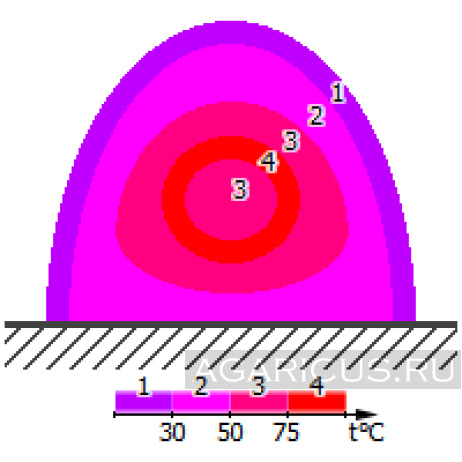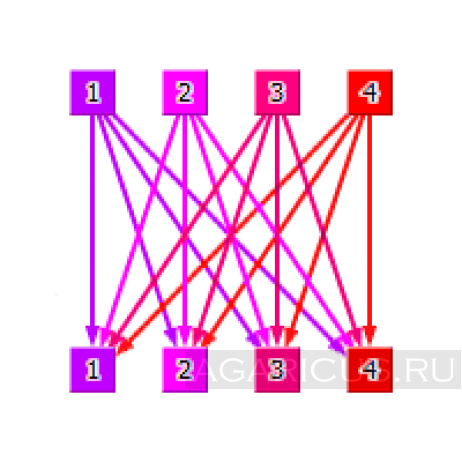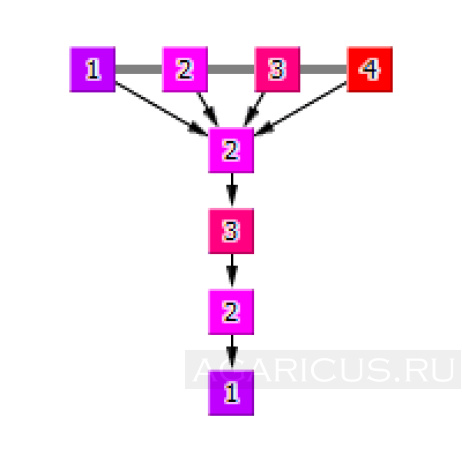Introduction
Before we start describing the 2nd phase of compost preparation, we want to remind that the information presented below is only the author’s thoughts, based on and proved by his practical experience. And these thoughts don’t claim to be an absolute truth.
2nd phase of composting, what is it? What is its meaning? What conditions and parameters are needed to carry it out? The answers to these and other questions can be obtained after a more detailed analysis of the 1st phase of composting.
Figure1. The thermal section of a compost pile.
While describing the 1st phase of composting we mentioned the role of compost’s temperature in the process of its preparation. Let’s discuss this aspect more thoroughly. Figure 1 shows the temperature section of working compost pile. As you can see in this drawing, a working compost pile consists of four basic temperature zones. Let’s discuss each one more thoroughly.
The first temperature zone - the temperature is less than 30°C. That’s the surface of the pile. Its temperature depends on the environment’s temperature and doesn’t differ from it much. The thickness (depth) of this layer depends on the stowing density, which depends on that compost’s humidity. The activity of the composting processes in this temperature zone is pretty low and this leads to a conclusion that with this compost mass temperature it might not be possible to get high quality 1st phase compost.
The second zone - the temperature is 30-50°C. A higher temperature in the given zone can practically have one explanation – composting processes are beginning here. In other words, processes of preliminary preparation of initial raw materials for further processing of mushroom nutrition begin in this zone. This supposition can be objective while testing the composting process from the lowest temperatures to the highest (figure 2). On the other hand, when the compost preparation is finished, this temperature zone is the last boundary before the first zone, in which the composting processes are absent. This leads to a conclusion that along with a beginning that takes place in the second temperature zone, there’s also an end of the 1st phase compost preparation. The end of phase 1 means a gradual decrease in the activity of the composting processes until they completely stop. At that, the compost is freed from ammonia, the presence of which is not good for mushrooms. Most likely these two processes (the preparation of raw materials and the end of composting) progress in parallel in the second temperature zone. In other words, there’s an initial processing of raw materials along with an assimilation of ammonia that forms during phase 1 at higher temperatures. The depth of this zone in practice can be a few centimeters, but sometimes this zone takes up the whole volume of the compost. It can be assumed that organic material, which is the basis of mushroom productivity, is lost more actively in this zone. Therefore, the first temperature zone plays an important role in the mushroom fruit body nutrition formation, but if there’s only the second zone present in the compost pile, especially for a long period of time, it most likely would impossible to obtain a high-yield compost.
Figure 2. The consequence of the temperature zones in phase 1 compost preparation.
The third temperature zone - the temperature is 50-75 degrees. Perhaps, that’s the most «working» zone of the compost. It’s unique because it is a link between a «live» compost preparation (as the result of the vital activity of the microorganisms) and a situation, when there are only chemical reactions without the participation of live organisms. This happens, when the temperature inside the compost is higher than 80 degrees. It can be said that this zone is responsible for not only the formation of food for the mushroom fruit bodies, but also for the food for mycelium growth in the compost. Obtaining high-quality compost without a sufficient volume of this zone is rather hard.
The fourth zone - the temperature is higher than 75 degrees Celsius. The activity of microorganisms at this temperature is practically absent. Here, chemical reactions dominate, which result in the formation of lignin humus nitrogen rich complex, which is necessary for the vegetative growth of mushroom mycelium. Based on many years of experience in compost preparation, it can be said that the compost’s quality directly depends on the compost mass’s volume, which passed through the fourth temperature zone.
Figure 3. The options of temperature zone distribution at compost mixing.
And now, let’s see what happens to the compost in different temperature zones at mixing (figure 3). In this picture we see that by the probability theory, the mixing the compost of all four temperature zones can be done in all possible combinations. The compost from the 1st zone can remain in the cold zone, or directly move to the fourth zone and vice versa. Bringing this thought to a logical conclusion, we ca assume that the prepared 1st phase compost is the mixture of four temperature zones, that is, along with the prepared compost, there might be areas where the composting processes haven’t started yet, or didn’t end properly. The correlation of the prepared and «not very prepared» volumes can be very different. The compost area’s technologist’s goal during the 1st phase of composting is to shift this correlation maximally in favor of the prepared compost. The options that help achieve this are various, from qualitative forming of compost piles, to using a bunker system to prepare 1st phase compost. But, unfortunately, none of these options help obtaining high-quality compost, using phase 1 only. In any case, there will still be areas of compost left, which haven’t passed fermentation, and that contain microorganisms that are harmful for mushrooms. For this reason, it’s rather hard to get 150 kg of mushrooms from a ton of 1st phase mushrooms.
Figure 4. A thermal chart of the pasteurization process.
In order to bring the 1st phase compost to complete suitability for mushrooms, the second phase of composting was created and called pasteurization. As seen in figure 4, phase 2 isn’t very different from phase 1. The first step is the same – the second temperature zone (the same problems are solved as in phase 1 – preparing areas of compost for fermentation, that is the areas that haven’t passed fermentation in phase 1). Then – the third temperature zone, which is necessary in phase 2 not only to solve problems that have to do with nutrition for mushrooms. Its other job is to free the compost of microorganisms that are harmful for mushrooms. After that, it’s the second zone again, in order to end the composting processes. And we cool the compost down to the spawning temperature level. As we can see, unlike in phase 1, there is no fourth temperature zone. The reason for this is if the compost is heated to the fourth zone temperature, then we’ll get rid not only of the harmful microorganisms, but also the helpful ones, and so, there won’t be anything to end the composting processes. The reason for this is that in phase 2 of compost preparation, unlike in phase 1, the necessary temperatures are supported in the whole volume of compost. At the same time, this situation practically excludes the presence of areas in the compost in the end of phase 2, that aren’t ready for mushroom cultivation.
2nd phase of composting, what is it? What is its meaning? What conditions and parameters are needed to carry it out? The answers to these and other questions can be obtained after a more detailed analysis of the 1st phase of composting.
Figure1. The thermal section of a compost pile.
While describing the 1st phase of composting we mentioned the role of compost’s temperature in the process of its preparation. Let’s discuss this aspect more thoroughly. Figure 1 shows the temperature section of working compost pile. As you can see in this drawing, a working compost pile consists of four basic temperature zones. Let’s discuss each one more thoroughly.
The first temperature zone - the temperature is less than 30°C. That’s the surface of the pile. Its temperature depends on the environment’s temperature and doesn’t differ from it much. The thickness (depth) of this layer depends on the stowing density, which depends on that compost’s humidity. The activity of the composting processes in this temperature zone is pretty low and this leads to a conclusion that with this compost mass temperature it might not be possible to get high quality 1st phase compost.
The second zone - the temperature is 30-50°C. A higher temperature in the given zone can practically have one explanation – composting processes are beginning here. In other words, processes of preliminary preparation of initial raw materials for further processing of mushroom nutrition begin in this zone. This supposition can be objective while testing the composting process from the lowest temperatures to the highest (figure 2). On the other hand, when the compost preparation is finished, this temperature zone is the last boundary before the first zone, in which the composting processes are absent. This leads to a conclusion that along with a beginning that takes place in the second temperature zone, there’s also an end of the 1st phase compost preparation. The end of phase 1 means a gradual decrease in the activity of the composting processes until they completely stop. At that, the compost is freed from ammonia, the presence of which is not good for mushrooms. Most likely these two processes (the preparation of raw materials and the end of composting) progress in parallel in the second temperature zone. In other words, there’s an initial processing of raw materials along with an assimilation of ammonia that forms during phase 1 at higher temperatures. The depth of this zone in practice can be a few centimeters, but sometimes this zone takes up the whole volume of the compost. It can be assumed that organic material, which is the basis of mushroom productivity, is lost more actively in this zone. Therefore, the first temperature zone plays an important role in the mushroom fruit body nutrition formation, but if there’s only the second zone present in the compost pile, especially for a long period of time, it most likely would impossible to obtain a high-yield compost.
Figure 2. The consequence of the temperature zones in phase 1 compost preparation.
The third temperature zone - the temperature is 50-75 degrees. Perhaps, that’s the most «working» zone of the compost. It’s unique because it is a link between a «live» compost preparation (as the result of the vital activity of the microorganisms) and a situation, when there are only chemical reactions without the participation of live organisms. This happens, when the temperature inside the compost is higher than 80 degrees. It can be said that this zone is responsible for not only the formation of food for the mushroom fruit bodies, but also for the food for mycelium growth in the compost. Obtaining high-quality compost without a sufficient volume of this zone is rather hard.
The fourth zone - the temperature is higher than 75 degrees Celsius. The activity of microorganisms at this temperature is practically absent. Here, chemical reactions dominate, which result in the formation of lignin humus nitrogen rich complex, which is necessary for the vegetative growth of mushroom mycelium. Based on many years of experience in compost preparation, it can be said that the compost’s quality directly depends on the compost mass’s volume, which passed through the fourth temperature zone.
Figure 3. The options of temperature zone distribution at compost mixing.
And now, let’s see what happens to the compost in different temperature zones at mixing (figure 3). In this picture we see that by the probability theory, the mixing the compost of all four temperature zones can be done in all possible combinations. The compost from the 1st zone can remain in the cold zone, or directly move to the fourth zone and vice versa. Bringing this thought to a logical conclusion, we ca assume that the prepared 1st phase compost is the mixture of four temperature zones, that is, along with the prepared compost, there might be areas where the composting processes haven’t started yet, or didn’t end properly. The correlation of the prepared and «not very prepared» volumes can be very different. The compost area’s technologist’s goal during the 1st phase of composting is to shift this correlation maximally in favor of the prepared compost. The options that help achieve this are various, from qualitative forming of compost piles, to using a bunker system to prepare 1st phase compost. But, unfortunately, none of these options help obtaining high-quality compost, using phase 1 only. In any case, there will still be areas of compost left, which haven’t passed fermentation, and that contain microorganisms that are harmful for mushrooms. For this reason, it’s rather hard to get 150 kg of mushrooms from a ton of 1st phase mushrooms.
Figure 4. A thermal chart of the pasteurization process.
In order to bring the 1st phase compost to complete suitability for mushrooms, the second phase of composting was created and called pasteurization. As seen in figure 4, phase 2 isn’t very different from phase 1. The first step is the same – the second temperature zone (the same problems are solved as in phase 1 – preparing areas of compost for fermentation, that is the areas that haven’t passed fermentation in phase 1). Then – the third temperature zone, which is necessary in phase 2 not only to solve problems that have to do with nutrition for mushrooms. Its other job is to free the compost of microorganisms that are harmful for mushrooms. After that, it’s the second zone again, in order to end the composting processes. And we cool the compost down to the spawning temperature level. As we can see, unlike in phase 1, there is no fourth temperature zone. The reason for this is if the compost is heated to the fourth zone temperature, then we’ll get rid not only of the harmful microorganisms, but also the helpful ones, and so, there won’t be anything to end the composting processes. The reason for this is that in phase 2 of compost preparation, unlike in phase 1, the necessary temperatures are supported in the whole volume of compost. At the same time, this situation practically excludes the presence of areas in the compost in the end of phase 2, that aren’t ready for mushroom cultivation.





Lko:
Saheb hamare mushroom dry bable se pura form doob chuka hai ismein Ham Kya Karen Sahab Koi upay Ho to...
Production of Compost, Personal opinion (part 3). Wet...Abimbola Olaniyi-Balogun, Lagos Nigeria:
Hello there, I made mushroom compost using the long composting method. I used wet chicken manure, fresh...
Mushrooms in KazahstanZagreb, Croatia:
My name is Zlatko Vidmar.
Without chicken manure compost? Yes, it's possible...I am in modern mushroom growing over 40 years.
I see your farm and if...
nanyuki:
my email is samuelnjogo@gmail.com
Without chicken manure compost? Yes, it's possible...nanyuki:
i want to learn like a child on compost making for mushroom
Mushrooms in KazahstanVELLORE TAMILNADU INDIA:
SUITABLE JOBS – MUSHROOMS GROWER / COMPOST / SPAWN OR RELAVANT FIELDS
Without chicken manure compost? Yes, it's possible...Dear Hiring Manager...
Patna:
PLEASE SEND YOUR FORMULA without-chicken-manure-compost
watering first flush mushroomswasil, Malaysia:
i suggest you not to water on mush just maintain the good humidity if you not have any auto system for...
Compost Production. Personal opinion (Part 2)NARENDER SEHRAWAT, FARIDABAD NCR:
COMMON PROBLEM IN PHASE 1 BUNKAR IS THE UNBALANCED TEMERATURE, IT STARTS FROM 50-55 DEGREES TO 78-82...
Without chicken manure compost? Yes, it's possible...Hannes, Plettenberg Bay, South Africa:
Can you give me more details on compost without chicken manure for mushroom growing, what alternatives...